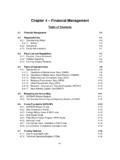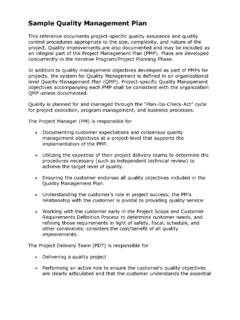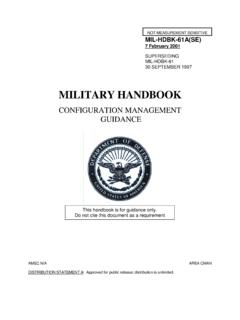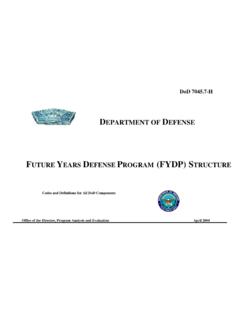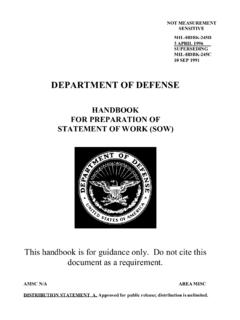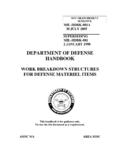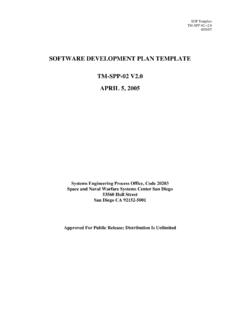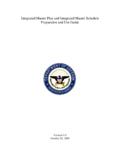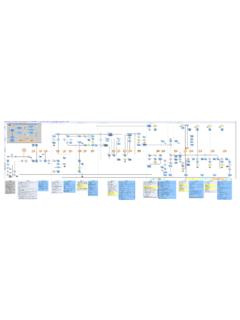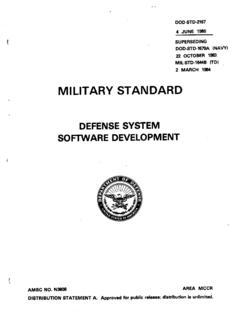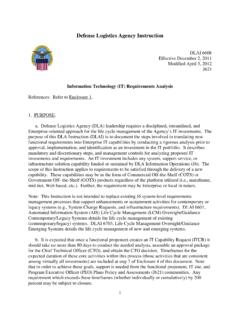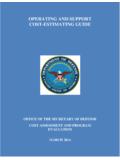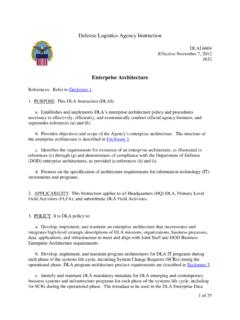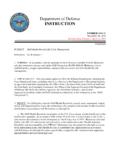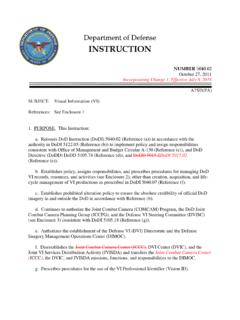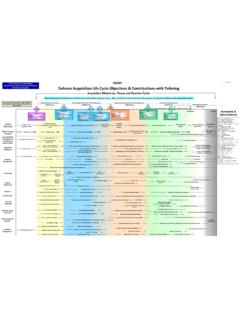Transcription of A Guide for mAnAGers - AcqNotes
1 | 3A Guide for dod ProGrAm mAnAGers80 Percent of What Departmentof defense Program mAnAGers Needto Know to Run an Effectiveand Efficient ProgrambyWilliam T. Cooley and Brian C. RuhmDecember 2014 PublishED by thEDEfENsE acquisitioN uNivERsity PREssfoRt bElvoiR, viRgiNia| 4 PrefacePREFACEThe first responsibility of the key leaders in the acquisition workforce is to think. Frank Kendall1 Under Secretary of defense for Acquisition, Technology, and Logistics Please read this first.
2 We say this because we want readers to un-derstand why we wrote this book, for whom we wrote it, and what we ac-knowledge as the limitations of what we have to offer. We believe that success as a program manager (PM) begins with the way you think about the job. Toward that end, the goal of this book is to help calibrate your brain for program management duty. Entering into the right frame of mind to execute your responsibilities is not easy, but is vitally important. Even as experienced PMs, we wanted to find a Program management for Dummies2 book to check so that we did not overlook something obvious.
3 To our surprise, the book didn t We believe even experienced PMs can benefit by recalibrating their think-ing. We hope the book before you will help you understand your role as a PM and successfully navigate the complex and dynamic environment of department of defense (DoD) acquisition. DoD acquisition management demands specialized skills and knowledge, which may find application in other program management environments but which are unique to the DoD acquisition system. Individuals assuming program management responsibility for the first time will be challenged to succeed if they lack a basic understanding of DoD program management principles, processes, and terminology.
4 This book seeks to provide that foundation a beginners Guide and quick ref-erence to the foundation of good program management . This book reflects our belief that leadership matters and that effective PMs can significantly influence the likelihood that a program will succeed. Running almost any size program or project entails work-ing with a diverse program management team. It also entails collaborat-ing with other members of the DoD community users and warfighters (customers, in traditional parlance), program advocates, members of the Service or Joint Staffs, industry representatives, and even members of Congress whose goals and agendas may or may not align with your own.
5 Whether in guiding your own program management team or seeking so-lutions with other members of the DoD community, the PM s job requires active and decisive leadership to keep a program on track. You must fos-1 frank Kendall, The optimal Program structure, defense AT&L 41, no. 4 (2012), pp. Project management for Dummies by stanley e. Portny is available, but it has limited applicability to the structured dod program management environment. Preface| 5ter consensus and support among your staff to ensure program success. Leadership is essential and is discussed in detail among the intangible qualities of program management later in this book.
6 The defense Acquisition University (DAU), the Program management Institute, and a variety of other organizations offer count-less training courses that go into more depth and detail than we offer in this book. Our own experience with these other training sources has been almost entirely positive, and we strongly encourage readers to pur-sue more in-depth training from these organizations. The purpose of this book is not to replace or subvert these training and education venues but rather to jump-start and supplement their offerings.
7 We also know that people learn through a variety of ways and hope to provide an aid for those who learn by reading books or stories and those who have time on airplanes to read after reviewing the Sky-Mall catalog sitting in front of them. We have written the book with an eye toward an O-5- or O-6-level officer (or comparable civilian grade) about to take over a large weapon-system program, but we like to think that most of the ideas in this book are scalable. That is, the lessons and recommendations are nearly as use-ful for a junior company-grade officer or civilian responsible for a small program or subsystem as they are for a flag-level or general officer re-sponsible for a multibillion-dollar major defense acquisition program (MDAP) or major acquisition information system (MAIS).
8 Although this book represents more than 45 years of collective experience in DoD acquisition and program management , it s important to understand that it also reflects the unique perspective, experience, and opinions of its two primary authors. Because both authors come from an Air Force background, it reflects an Air Force perspective and, in some instances, Air Force-unique terminology. Although we have attempted to bring a Joint perspective and avoid a Service-specific lens, we acknowl-edge our bias. By and large we believe there are right ways and wrong ways to run a program.
9 If a reader disagrees with some of our assertions, that s a good thing. It affirms our belief that program management is a thoughtful discipline that does not lend itself to dogma, cookie-cutter solutions, or one-size-fits-all processes. This book was never intended to be a comprehensive how to Guide or an exhaustive survey of program management topics. More than anything else, it represents a collection of lessons learned in the areas that we believe are critical to program success. This book is intended to provide a way to think about your role as PM and build a foundation of knowledge upon which you can better navigate the endlessly complex DoD acquisition and program management process.
10 | 6 AcknowledgmentsACKNOWLEDGMENTS The ideas and lessons contained here are not entirely the au-thors . We benefited greatly from the wisdom of numerous PMs and ac-quisition leaders within the Air Force, Army, Navy, and Marines, as well as among our defense industry partners. We are particularly indebted to the faculty and staff at DAU. Dr. Roy Wood, dean of the defense Systems management College (DSMC) supported this effort from the time he learned of it. He contributed a great deal to ensure the book was published by DAU Press and to the refinement of this book by asking his staff of acquisition experts to review the work, paying special attention to the areas of their expertise.
